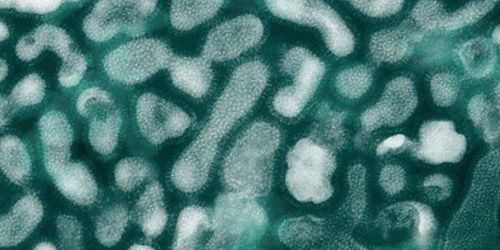St. Jude Family of Websites
Explore our cutting edge research, world-class patient care, career opportunities and more.
St. Jude Children's Research Hospital Home

- Fundraising
St. Jude Family of Websites
Explore our cutting edge research, world-class patient care, career opportunities and more.
St. Jude Children's Research Hospital Home

- Fundraising
The beginning of the end for the annual flu shot?

Researchers from St. Jude and the University of Georgia are leading one of three new vaccine development centers to develop a more broadly effective and possibly longer-lasting influenza vaccine.
Just in time for the flu season comes news that federal health officials are pumping millions into developing more broadly effective and possibly longer-lasting influenza vaccines.
Not surprisingly, St. Jude Children’s Research Hospital scientists are involved.
Stacey Schultz-Cherry, PhD, of Infectious Diseases, and Ted Ross, PhD, of the University of Georgia, will lead one of three new vaccine development centers.

Stacey Schultz-Cherry, PhD
The centers are funded by the National Institute of Allergy and Infectious Diseases, part of the National Institutes of Health. The effort includes support to manufacture and test the most promising vaccine candidates. Funding for the initiative, known as the Collaborative Influenza Vaccine Innovation Centers or CIVICs, will total about $51 million the first year.
The goal? Create vaccines that in a single dose protect more children and adults against multiple flu strains. Success might mark the beginning of the end of the annual flu shot.
“We are particularly focused on developing vaccines that protect the most vulnerable populations,” Schultz-Cherry said. They include young cancer patients, pregnant women, people age 65 and older, plus those who are obese or have chronic health problems such as asthma and diabetes.
“These are the folks who, if infected, will develop the most severe disease,” she said. They also are less responsive to current flu vaccines.
Flu by the numbers
While most people recover from flu infections, flu remains the sixth leading cause of death in the U.S. An average flu season includes about 114,000 hospitalizations in the U.S. and about 36,000 deaths. The toll can be much higher. Federal officials estimate there were about 79,400 flu-related deaths in the U.S. during the 2017—2018 flu season. Close to 1 million adults and children were hospitalized.
Today’s vaccine
The annual flu vaccine remains the best way to prevent the infection and serious, even life-threatening complications. It is recommended for almost everyone 6 months and older. The current vaccines are designed to protect against as many as four viruses.
Change is a constant for the flu virus. That explains why flu shots are a fall ritual. It also explains why vaccine effectiveness varies from flu season to flu season. Vaccine production takes months. The flu strains in this year’s vaccine were selected by researchers in late winter. The timeline gives the virus a window to change in ways that reduce vaccine effectiveness.
In a good year, the vaccine is 70% to 90% effective at protecting healthy children and adults age 64 and younger. But research from St. Jude scientists and others has shown the vaccine is less effective in older people, pregnant women, obese individuals and those with diabetes, asthma and other chronic disorders.
Tomorrow’s vaccine
The Center for Influenza Vaccine Research for High Risk Populations aims to close the effectiveness gap. The center combines the expertise of investigators from 14 universities and research institutes. Ross and Schultz-Cherry are the director and co-director, respectively. The seven-year NIH project will invest as much as $130 million in developing a candidate vaccine from the University of Georgia.
The overall goal of the new centers is to develop a vaccine that provides universal protection against all or at least most human and animal flu viruses. But Schultz-Cherry emphasized that an important first step is creating a vaccine that is more broadly protective in all populations against the human flu strains. “We are really excited and confident that more broadly protective, longer lasting vaccines are possible with the ultimate goal being a universal vaccine,” she said.
St. Jude role
St. Jude researchers bring expertise in recognizing and understanding the basis of high-risk flu infections. For this project, St. Jude scientists will focus on the vaccine development pipeline, including everything from identifying the vaccine’s immune signature and modeling high-risk flu infections to making the reagents and developing the assays to test vaccine effectiveness.
“We want to know which vaccines work best and why and do that as quickly as possible,” Schultz-Cherry said. The work will involve St. Jude scientists and staff from across the institution.
Flu at St. Jude
St. Jude has a long and storied role in flu research that continues today.
In the 1970s, Robert Webster, PhD, an emeritus member of the St. Jude Department of Infectious Diseases, helped identify aquatic birds as the world reservoir for flu viruses.
Today, St. Jude is home to the World Health Organization Collaborating Center for Studies on the Ecology of Influenza in Animals and Birds. The center is focused on how the flu virus mutates as it passes from birds to other animals and ultimately to humans. The center operates a global network that tracks the spread of new influenza strains.
St. Jude is also home to the National Institutes of Allergy and Infectious Diseases Center of Excellence for Influenza Research and Surveillance. The mission includes understanding the threat to humans from flu viruses of animals. Better flu treatments and vaccines are another goal.






